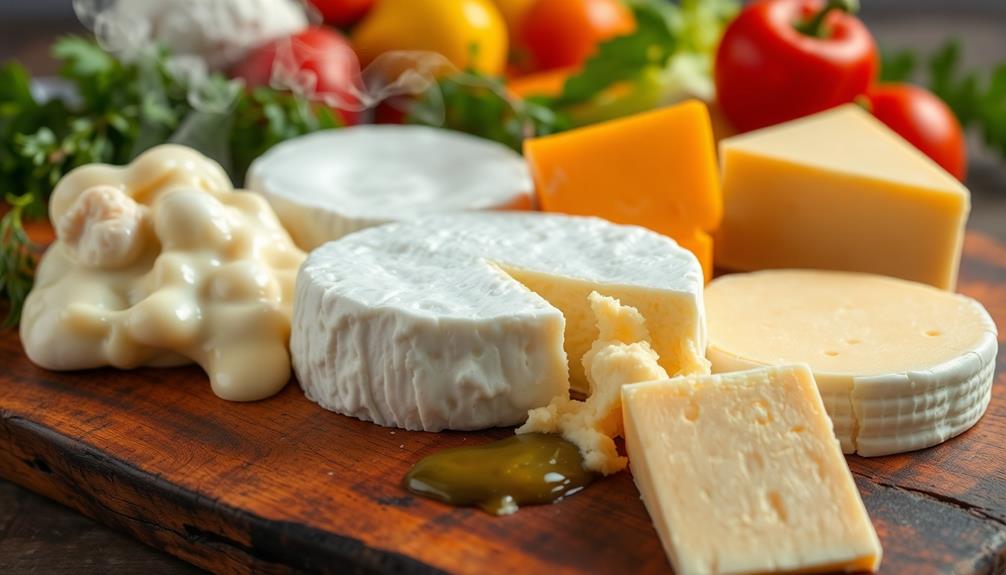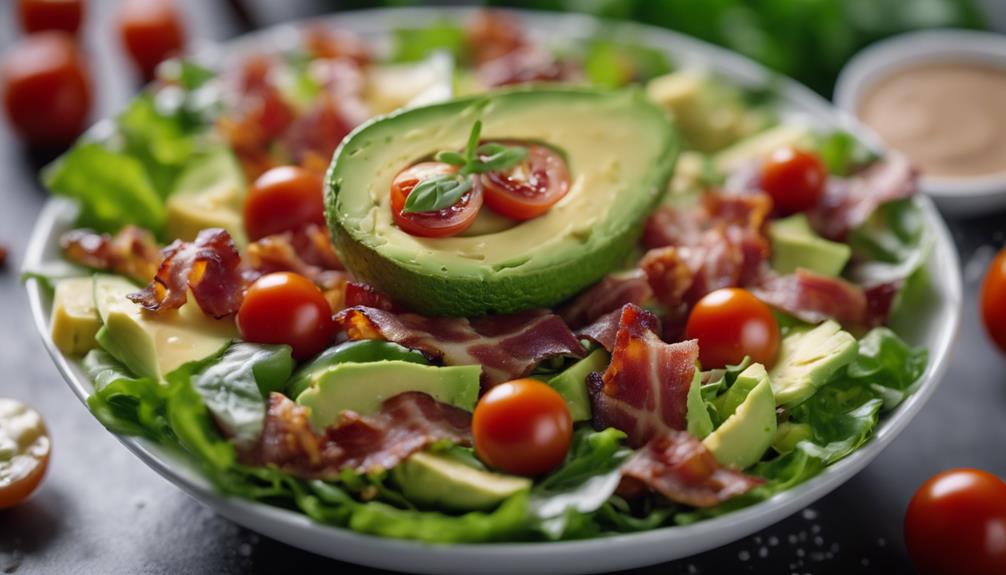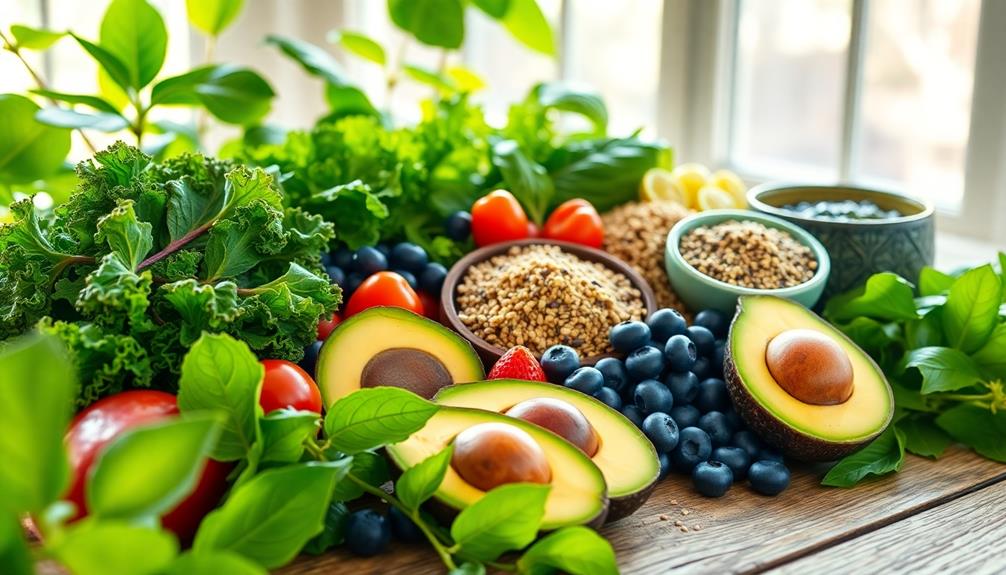Some cheeses melt beautifully while others resist heat, and you can thank factors like moisture content, fat levels, aging, and protein structure for this. Cheeses like mozzarella, with high moisture, melt smoothly because their proteins are loosely packed. In contrast, aged cheeses contain less moisture, causing them to become grainy or oily. Higher fat cheeses, like Brie, also melt better since fat enhances creaminess. You'll find that younger cheeses generally melt more easily than their aged counterparts. If you're curious about which cheeses are ideal for melting or how to enhance their melting properties, there's plenty more to explore.
Key Takeaways
- Cheeses with high moisture content, like mozzarella, melt smoothly due to loosely packed protein networks.
- Aged cheeses have lower moisture and develop crystalline structures, hindering their melting abilities.
- Higher fat content enhances melting properties, resulting in a creamier texture and smoother melt.
- Cheeses with high acidity, such as feta, resist melting due to tightly bound proteins.
- Preparation methods, like grating and gradual heating, significantly impact the melting quality of cheese.
Factors Influencing Cheese Melting
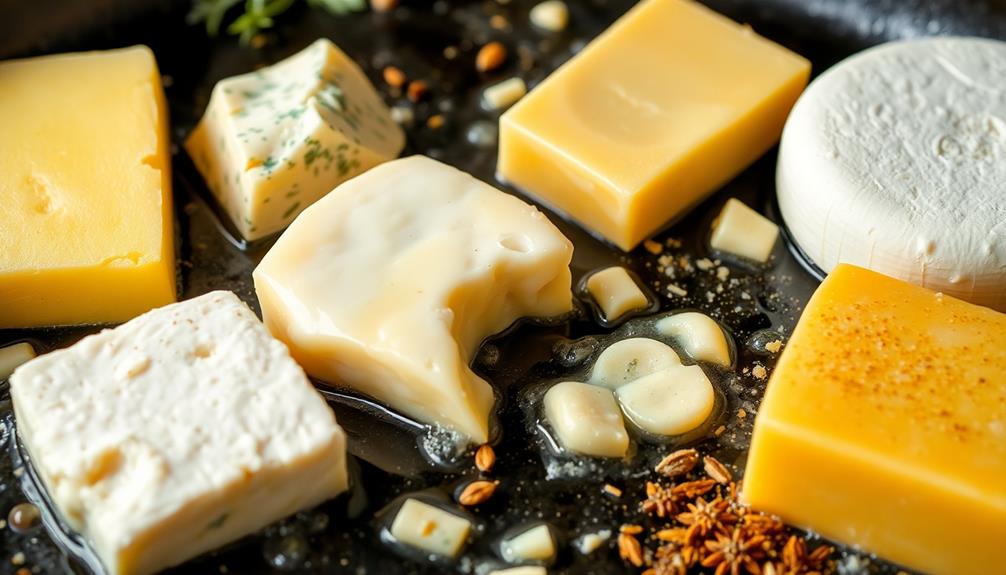
When it comes to cheese melting, several key factors influence how well a cheese will perform under heat. One major factor is moisture content; cheeses like mozzarella, which have higher moisture levels, melt better because their loosely packed protein networks allow fluid movement when heated.
Conversely, aged cheeses often develop crystalline structures that impede smooth melting, making younger varieties, like fresh cheddar, easier to melt. Additionally, the texture and moisture content of cheeses can be influenced by regional culinary traditions, much like how different states in Brazil offer unique takes on traditional dishes, showcasing diverse ingredients and flavors regional culinary traditions.
Fat content also plays a vital role. Cheeses with higher fat concentrations, such as brie and raclette, enhance melting properties, as fat acts as an emulsifier, giving a creamy texture when melted.
Meanwhile, acidity levels matter too. Cheeses with high acidity, like feta and paneer, don't melt well since their proteins are tightly bound and resist liquefying under heat.
Lastly, the curdling process influences melting quality. Cheeses that undergo rennet coagulation, like gouda, typically melt better than acid-set cheeses, which maintain their structure and don't liquefy.
The Science of Cheese Melting
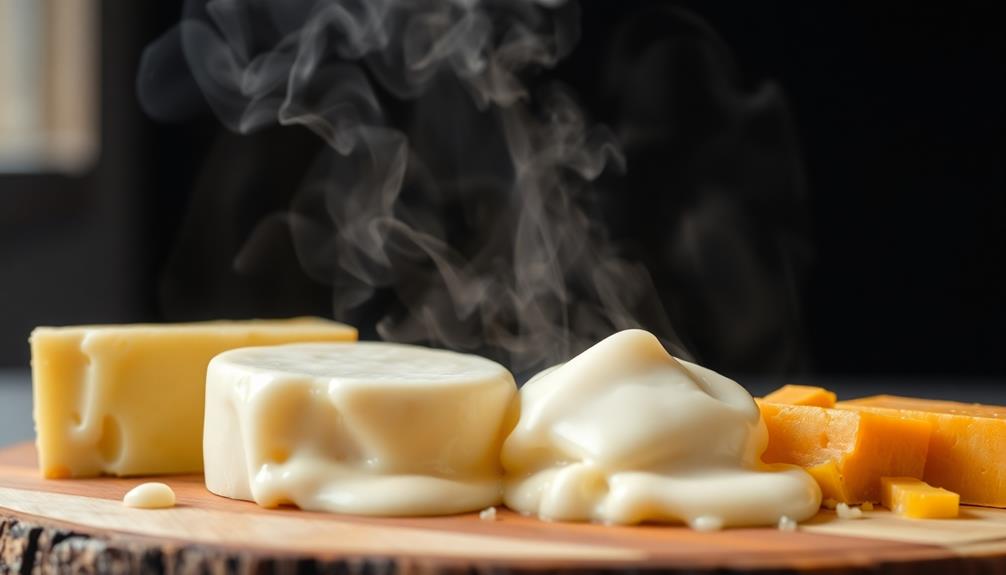
When you think about cheese melting, moisture content, fat, and aging are key factors to weigh. Higher moisture cheeses melt beautifully, while the fat content determines how smooth the melting process will be.
For instance, creamy cheeses like those used in traditional Red-Braised Pork Belly can achieve a delightful melt when prepared correctly.
Plus, the age of the cheese can either enhance or hinder its ability to melt, affecting your cooking experience.
Moisture Content Impact
Understanding how moisture content impacts cheese melting is essential for achieving the perfect melt in your dishes. The moisture level plays a vital role in how well cheese melts. High-moisture cheeses, like mozzarella and brie, have a loosely packed protein network that facilitates a smoother, creamier melt.
In contrast, drier cheeses, such as Parmesan, often struggle to achieve a desirable texture when heated. Additionally, the culinary traditions from around the world often highlight the use of high-moisture cheeses in dishes like Italian indulgences, where melty textures are celebrated. This characteristic enhances dishes such as Zabaglione, where creamy textures are key for the overall experience.
Here are some key points to keep in mind:
- Cheeses with moisture content above 45% generally melt better.
- High-moisture cheeses release water upon heating, maintaining a desirable melting quality.
- Aged cheeses have lower moisture content, leading to firmer textures that can become grainy or oily.
- Low-moisture cheeses may become tough or crumbly when melted.
Fat's Role in Melting
Enhancing your cheese melting experience hinges on the fat content present in the cheese. Higher fat levels greatly improve melting properties, yielding smoother and creamier textures when melted. For instance, mozzarella, with its rich fat content, showcases excellent meltability, allowing fat molecules to facilitate oil flow during heating.
This principle of fat's importance in texture is similar to how the rich crema enhances the flavor profile in dishes like Chilaquiles.
In contrast, lower-fat cheeses tend to create grainy or undesirable textures upon melting. This is because they lack the sufficient fat needed for a cohesive melt. The emulsification process plays a key role here, as fat acts as a binder, ensuring even melting. You'll often notice this effect in processed cheeses, which are specifically designed for consistent meltability.
It's important to recognize that fat not only influences melting behavior but also affects flavor and mouthfeel. When you select cheese for melting applications, consider the fat content carefully.
Cheeses with higher fat levels will likely deliver a more enjoyable experience, enhancing both the texture and taste of your favorite dishes. So, whether you're making a pizza or a cheesy dip, prioritize fat-rich options for the best melting results.
Aging Effects on Texture
The texture of cheese plays a significant role in its melting qualities, and aging has a profound impact on this aspect. As cheese ages, you'll notice that the protein structure becomes more tightly packed, which hinders the melting capabilities compared to younger cheeses. This is somewhat similar to how certain traditional Japanese confections, like Dorayaki (Red Bean Pancake), maintain a soft texture that appeals to many.
The decrease in moisture content also contributes to a harder texture, making it less conducive to melting. For instance, aged Parmigiano Reggiano is known for this property.
Here are some key effects of aging on cheese texture:
- Decreased moisture: Leads to a firmer, less melt-friendly cheese.
- Crystalline structures: Develop in aged varieties, resulting in a grainy texture.
- Elasticity: Younger cheeses, like fresh mozzarella, maintain a more elastic protein network.
- Fat concentration: As moisture evaporates, fat can concentrate, creating an oily texture instead of a smooth melt.
Understanding these factors helps explain why younger cheeses often melt better than their aged counterparts. By appreciating how aging affects moisture, protein, and overall texture, you can make more informed choices the next time you cook with cheese.
Ideal Melting Cheeses
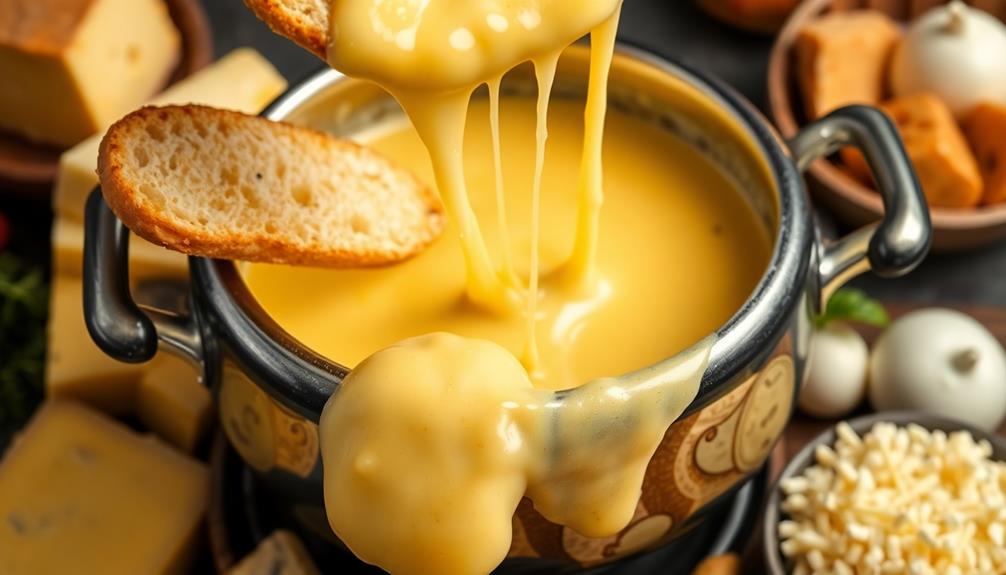
When it comes to melting cheese, what makes some varieties stand out from the rest? The ideal melting cheeses usually have high moisture content and specific fat compositions. Here's a quick look at some of the best melting cheeses you should consider:
| Cheese | Melting Qualities |
|---|---|
| Mozzarella | High moisture, stretchy texture, perfect for pizza |
| Brie | Creamy consistency when baked, especially without rind |
| Gruyère | Smooth melting, rich flavor, excellent for fondue |
| Fontina | Rich and creamy melt, great for sauces and bakes |
| American Cheese | Engineered for consistent melting, ideal for burgers |
Mozzarella is a must-have for pizza lovers due to its stretchy and gooey texture. Brie transforms into a delightful creamy goodness when baked, making it a favorite for appetizers. Gruyère and Comté shine in fondue, offering smooth melting and depth of flavor. Fontina's high-fat content guarantees a luxurious melt, great for enhancing dishes. Finally, American cheese, with its processed properties, delivers a reliable melt, making it perfect for grilled cheese sandwiches.
Techniques to Enhance Melting
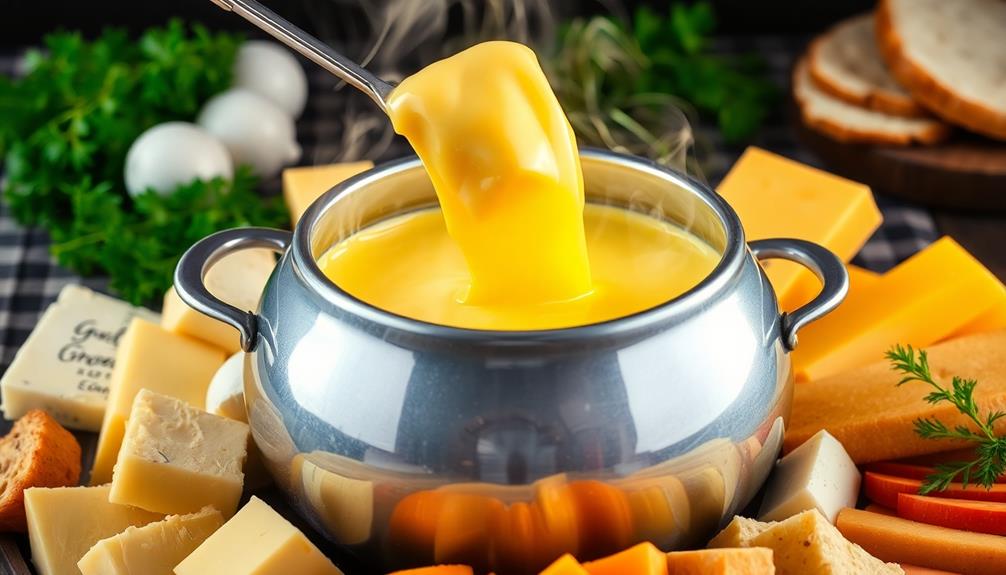
To achieve the perfect melt, it's crucial to start with the right preparation techniques. When you're aiming for melting cheeses that melt better, consider these key strategies:
- Bring cheese to room temperature: This promotes even heat distribution, enhancing the melting process. Particularly, using cheeses that are rich in moisture, such as burrata, can further elevate your dishes by providing a creamy texture that complements a variety of ingredients, including grilled fruits like peaches and fresh greens from a Grilled Peach and Burrata Salad.
- Incorporate cornstarch or flour into cheese mixtures: This helps achieve a smoother melt by preventing fat separation during heating.
- Use gradual heating: Stick to low to medium heat to avoid making the proteins oily or stringy, ensuring a better melt.
- Experiment with béchamel sauce: Using this as a base improves the overall consistency and meltability of your cheese dishes.
Cooking Tips for Melty Cheeses
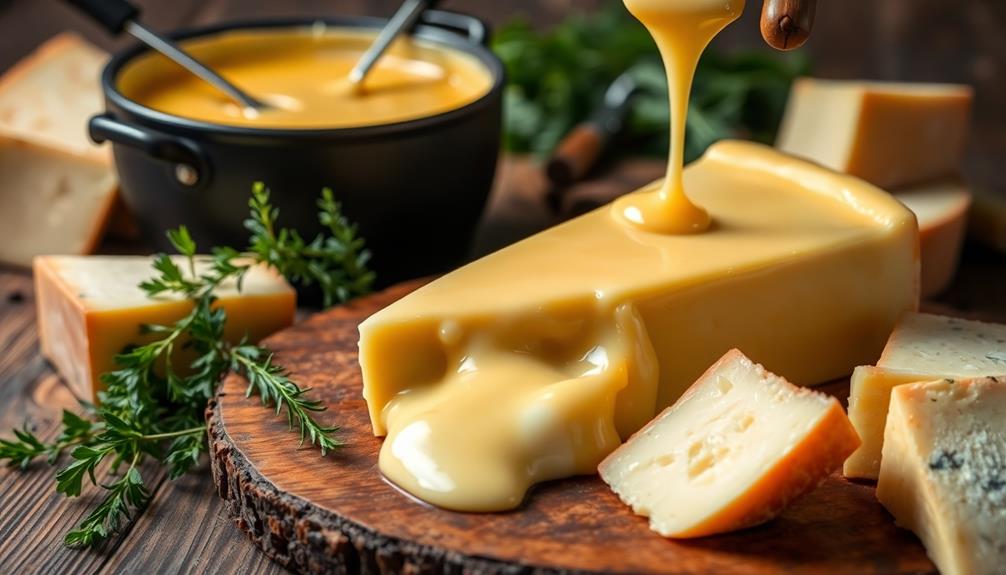
To achieve the perfect melt, let your cheese come to room temperature before cooking.
Grating it will also guarantee a quick and even melt, making your dish creamier.
For instance, cheeses like cheddar and mozzarella are popular in American diner classics like Loaded Baked Potato and can deliver that desired gooey texture. Additionally, these cheeses can also be used to create a creamy macaroni and cheese recipe that is a hit among both kids and adults. The rich and savory flavors of cheddar and mozzarella enhance the dish, making it a comfort food favorite. Their meltability and ability to blend seamlessly with other ingredients make them a go-to choice for countless American comfort foods.
Room Temperature Preparation
Achieving the perfect melt with cheese starts long before it hits the heat—letting it come to room temperature is key. This simple step enhances melting potential by promoting even heat distribution.
When cheese is at room temperature, you'll notice a significant improvement in texture and taste, especially with higher moisture varieties like mozzarella and brie. Additionally, certain cheeses, such as those used in traditional Italian dishes, can offer unique melting characteristics that enhance the overall flavor of your meal, like the creamy consistency found in Agnolotti.
To maximize your cheese's melting capabilities, consider these tips:
- Timing: Let cheese sit out for about 30 minutes to an hour before cooking, depending on its type and size.
- Avoid Cold Shock: Gradually warming cheese prevents it from becoming oily or stringy when exposed to high heat.
- Creamy Consistency: Room temperature cheese retains its creamy texture, making it ideal for dishes that require smooth melting.
- Recipe Perfection: Using cheese at room temperature guarantees a delightful melting experience in grilled cheese sandwiches, cheese sauces, and more.
Grating for Even Melting
Grating cheese is one of the best ways to guarantee a smooth and even melt in your dishes. When you grate cheese, you increase its surface area, allowing it to melt better and faster compared to using whole blocks.
For example, using freshly grated cheese in a dish like squash casserole can assure that it blends seamlessly with other ingredients. The finer the shreds, the more uniformly they melt, making them ideal for sauces and toppings where you want that consistent meltability.
Skipping the grating step can lead to uneven melting, resulting in clumps of cheese that may not fully melt during cooking. To assure you get the best results, always opt for fresh cheese instead of pre-grated varieties, which often contain anti-caking agents that can affect melting quality.
Freshly grated cheese integrates more effectively with sauces or other ingredients, enhancing the overall flavor and mouthfeel of your dishes.
Gradual Heating Techniques
The secret to perfect cheese melting lies in the technique of gradual heating. This method not only helps cheeses melt better but also guarantees a creamy, smooth texture. High-moisture cheeses melt best around 130°F, while aged cheeses need about 150°F.
For example, when preparing dishes like Mushroom Masala, utilizing great melting cheeses can enhance the overall flavor profile.
Here are some tips to master gradual heating:
- Bring cheese to room temperature before cooking to enhance its melting potential.
- Use low and slow cooking methods to prevent fats and proteins from separating, which can lead to undesirable textures.
- Incorporate moisture, like a splash of white wine or broth, to maintain a smooth texture and prevent toughness.
- Utilize gentle heat techniques, such as steaming or a double boiler, for even melting without burning.
Common Melting Mistakes
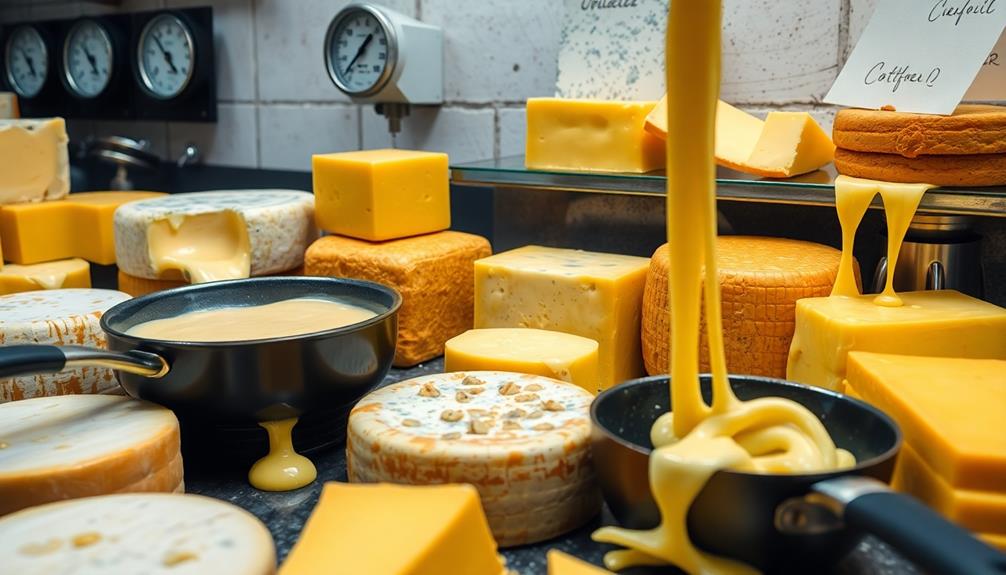
When melting cheese, several common mistakes can compromise your results. One of the biggest errors is opting for low-fat cheeses. These often lack the fat content necessary for a smooth melt, leading to undesirable textures. Stick to good melting cheese with a higher moisture content for better results.
Another mistake is skipping the grating process. Whole blocks take much longer to melt, resulting in uneven textures that just won't satisfy.
Rapid heating is another pitfall. If you crank up the heat, you risk turning your cheese oily or stringy, which isn't what you want. Instead, gradually heat your cheese to maintain its texture and flavor.
Additionally, using aged cheeses can be problematic; younger varieties are preferable since their relaxed protein structures facilitate melting better.
Culinary Applications for Melting Cheeses
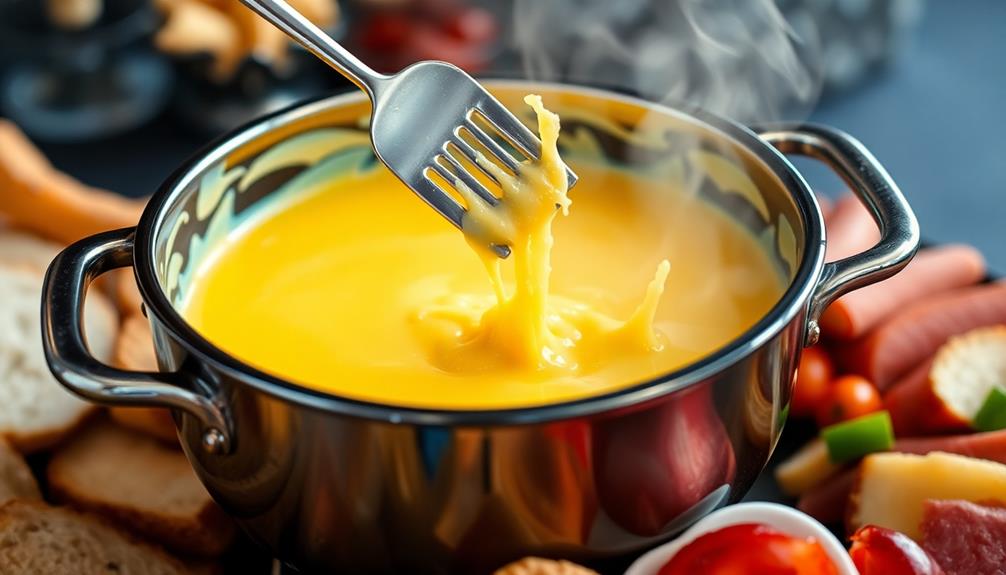
Melting cheeses play a pivotal role in a variety of beloved dishes, enhancing both texture and flavor.
You'll find that using the right melty cheeses can transform your meals into culinary delights. Here are some popular applications:
- Pizza: Mozzarella's stretchiness makes it a favorite for a gooey, satisfying slice.
- Cheese Fondue: A blend of Gruyère and Emmental creates a creamy, cohesive melt perfect for dipping.
- Grilled Cheese Sandwiches: Cheddar and American cheese offer that gooey texture you crave.
- Casseroles and Lasagnas: Ricotta and mozzarella not only melt beautifully but also add creaminess and depth of flavor.
Higher in fat, these melting cheeses provide the rich, satisfying textures that elevate your dishes.
Whether you're whipping up nachos or a decadent cheese sauce, the choice of cheese can make all the difference.
So, next time you're cooking, remember to select your melting cheeses wisely to guarantee your culinary creations shine.
Embrace the power of melty cheeses to bring comfort and joy to every meal you prepare!
Different Cheese Types and Melting
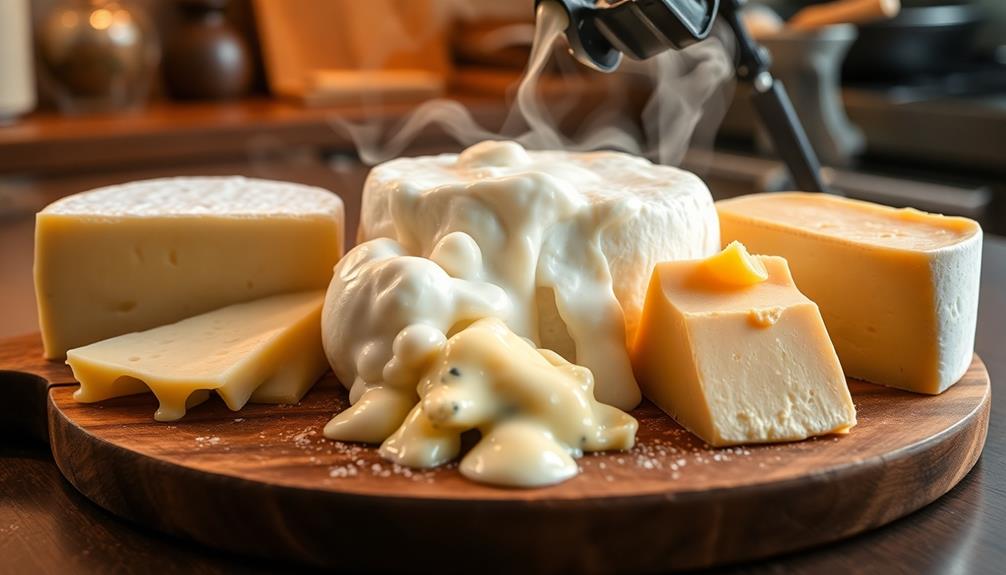
Cheese types greatly impact how well they melt, making it essential to choose wisely for your cooking needs. Cheeses with high moisture content, like mozzarella and provolone, melt beautifully because their loosely packed protein structures allow fluid movement when heated.
In contrast, aged cheddar and other older cheeses can develop crystalline structures that hinder their melting abilities, resulting in a grainy texture.
Younger cheeses, such as fresh gouda, typically melt more smoothly, while acid-set cheeses like feta and goat cheese won't melt well at all. Their firmer textures are a result of the acid curdling process, which retains shape when heated.
The fat content in cheese is another critical factor. High-fat cheeses, such as raclette and fontina, melt uniformly, while low-fat varieties often turn grainy and struggle to melt properly.
If you're looking for guaranteed meltability, processed cheeses like American cheese are your best bet. These cheeses are engineered with emulsifiers to achieve a smooth texture that holds up under heat, making them ideal for melting in a variety of dishes.
Knowing these differences can help you select the perfect cheese for your culinary creations.
Recommended Gourmet Products
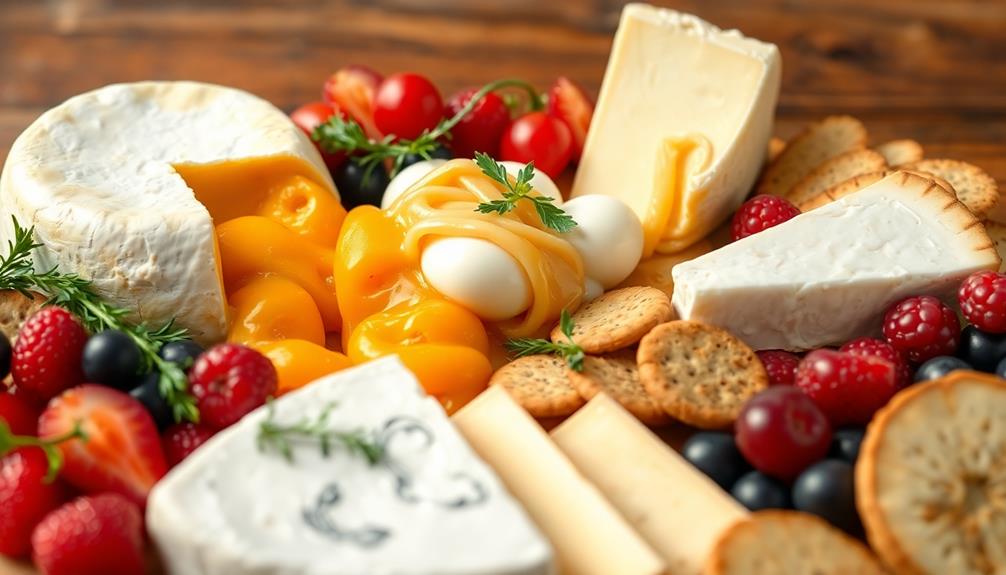
For anyone looking to elevate their culinary creations, high-quality gourmet products can make all the difference.
When it comes to melting cheeses, you'll want to explore the offerings from Markys Caviar and Gourmet Foods. Their selection includes cheeses known for their excellent melting properties, perfect for your next gourmet recipe.
Consider these gourmet products to enhance your dishes:
- Brie: This creamy cheese melts beautifully, adding a rich flavor to any dish.
- Fontina cheese: Renowned for its excellent melting properties, Fontina is perfect for sauces or fondue.
- Black Truffle Paste: An elegant addition to cheese boards, this paste will take your melted cheese presentations to the next level.
- Fresh truffles: Elevate your melted cheese dishes with the luxurious flavor that fresh truffles provide.
Frequently Asked Questions
Which Cheese Melts Better?
When you're choosing a cheese that melts better, go for mozzarella or brie. Their higher moisture and fat content help them melt smoothly, making them perfect for pizzas, pasta, or decadent cheese dishes.
Why Does Some Cheese Not Melt Properly?
Some cheeses don't melt properly because their protein structures are tightly bound, or they lack sufficient fat. High acidity and aging also contribute to graininess, preventing that smooth, creamy melt you're looking for.
What Determines if a Cheese Melts?
The melting ability of cheese depends on factors like moisture and fat content, age, production method, and acidity levels. You'll find cheeses with higher moisture and fat melt more smoothly compared to drier varieties.
Do Cheeses Have Different Melting Points?
Yes, cheeses have different melting points. While soft, high-moisture varieties melt easily, aged cheeses resist. You'll find creamy mozzarella oozing beautifully, while firm Parmesan stands steadfast, showcasing the fascinating diversity within the cheese world.
Conclusion
To summarize, understanding why some cheeses melt better than others can elevate your cooking. For instance, did you know that mozzarella has a melting point of around 130°F, making it perfect for pizzas? By choosing the right cheese and applying the right techniques, you can achieve that gooey, melt-in-your-mouth texture everyone loves. So next time you're whipping up a cheesy dish, remember these insights and enjoy the delicious results!
